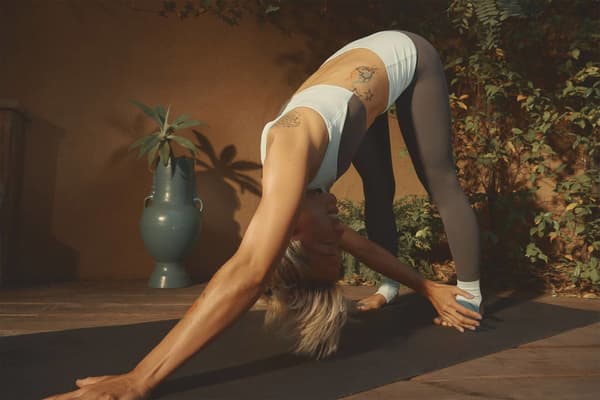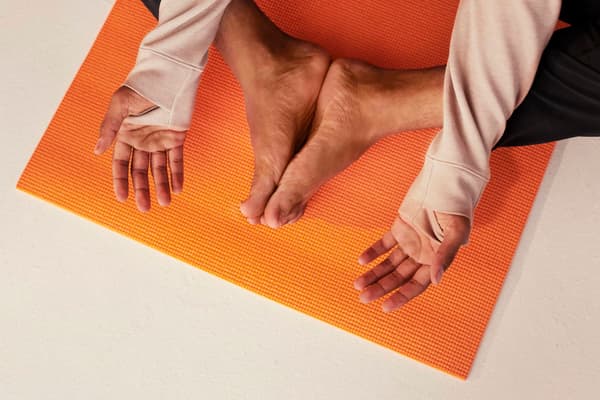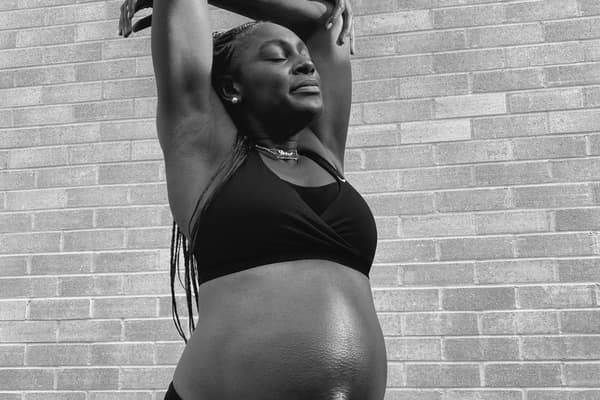5 Ways to Introduce Yoga Into Your Life
Sport & Activity
Whether you're a newbie to yoga or getting back into a routine, applying a daily practice can be advantageous to both your body and mind.

Yoga can be so much more than just physical exercise. For many people who practise yoga, it's a way of life that incorporates mindfulness and improves mental health. It can be a holistic way to benefit your health from the inside out.
Incorporating the benefits of yoga from the time you wake up to the time you sleep may seem like a far-fetched idea, but mindfulness practices and techniques—like meditating, breathing or stretching—can improve your well-being far beyond your time in the studio.
Making yoga a part of your lifestyle has the potential to change the way you look at your day-to-day life, helping you to be present, find inspiration, and focus on gratitude and positivity. One of the simplest ways to start is to breathe deeply when you're in stressful situations or feel overwhelmed. Even if you don't practise yoga daily (or at all), you can still incorporate mindfulness and breathing to reap the benefits in your everyday life.
Tips for Incorporating Yoga Into Your Daily Routine
1.Be Present
If you've ever been in a yoga class, you've probably heard about the importance of being present and in the moment, as you flow from breath to movement, centring yourself, closing your eyes and getting deep into the experience.
Staying in the moment means you're practising awareness and paying attention to the now. This can translate into other areas of your life in a number of ways, from work meetings to watching a film on the sofa with your partner. Make it a habit to stay present, focus on the person in front of you and your environment, rather than thinking of the past, worrying about the future or even mindlessly scrolling on your phone.
2.Practise Mindful Breathing
It's easy to allow the day to get away from us while we deal with life's stressors, like a busy work day or family responsibilities. Notice when you start to feel overwhelmed and take time to close your eyes and allow your focus to go to your breath. You may notice a big difference in your stress levels if you make a habit of taking breaks throughout the day to breathe deeply, relax and stay grounded.
The most basic breathing technique you can do is count. One simple option is called the 4-7-8 breathing technique, which is a breathing pattern based on an ancient technique called pranayama, which helps practitioners gain control over their breathing.
It's very simple: First, breathe in through your nose and count for four seconds. Hold your breath for seven seconds, then breathe out slowly through your mouth for eight seconds.
When You're Behind the Wheel
Meditation and mindfulness encompass a variety of different techniques—you don't always have to close your eyes to focus on clearing your mind. Mindfulness can simply mean being more aware of the present moment by noticing your breath, your body and your surroundings, which is actually the safest way to drive.
It's common practice for many people to practise mindfulness while walking, so why not while driving? Release your stress and regain focus and awareness behind the wheel by tuning into your body and your breath. Be aware of the present moment, and if you can do so while still focusing on the road, you can also choose a podcast or other audio to listen to as you're navigating through traffic. When you practise this type of mindfulness and awareness more frequently, it will start to become a habit.
Poses to Try at Your Desk
If you work at a desk—whether you're at home or in an office—you can easily incorporate yoga into your daily breaks. All you need to do is stand up and stretch by bending over and moving and elongating your spine. Not only will these exercises help with blood flow, but they may also help increase flexibility over time.
- Forward bend
Take five minutes to lean forwards and try to touch your toes. Start by standing with your legs hips-width distance apart. Raise your arms overhead and slowly lean forwards towards the floor. Try to bring your fingertips to your toes, and if needed, microbend your knees. Bring your weight to the balls of your feet so your hips stay over your ankles. As you bend forwards, exhale, and as you move back to standing, inhale.
You can also use your desk for support and lean forwards while stretching your arms and hands on top of your desk. Bend over slowly so your body is in the shape of an "L" from the side.
- Cat-cow
Sit next to your desk and try a few cat-cow poses on all fours. This pose stretches your back as you drop your belly towards the ground while your head moves upwards towards the ceiling. Then move your head back down so your gaze is towards your legs.
Stretch the space in between your shoulders by putting pressure on your hands and pushing the floor away. Breathe out and let go of the stale air and the mid-afternoon workday slump.
Another added benefit? You'll improve your posture, especially if you are sitting for the majority of the day.
Poses to Try During Mealtimes
You may have heard of intuitive eating, which promotes a healthy attitude towards food by tuning in to what your body needs and craves. This is similar to eating mindfully, which simply means taking each bite slowly rather than scoffing the food down, and allowing yourself to really taste what you're eating.
Mindfulness certainly extends to being aware of the kinds of foods you eat on a daily basis. If you're looking to focus on nutrition and create healthy eating habits, use this mindful tactic and make better choices that will fuel your body in a way that feels great and sets you up for success throughout the day.
3.Practise a Quick Sequence After Waking Up or Before Bed
If you're an early bird, you know there's something special about the morning: the newness of the day and the excitement of a fresh start. A great way to kick off the day on the right foot is with a quick yoga stretch and a few sun salutations, which is a series of 12 yoga poses that flow seamlessly together, to awaken the body and mind. Take a moment to pause and set a positive intention for the day.
If you're not a morning person, try evenings instead. Wrap up your evening with a few forward bends, cat-cows and 4-7-8 breathing exercises, and let go of the day's stresses. As you breathe with intention, reflect on what happened during the day and what you want to do differently tomorrow.
4.Take an Online Yoga Class
While you may want to suit up in new yoga apparel to help motivate your daily practice, the great thing about yoga is that you don't need much to get started, besides a yoga mat and comfortable clothing.
For professional guidance, consider signing up for a virtual class that you can take from the comfort of your own home. Nike Training Club offers a wide variety of options, including yoga and stretching classes. Videos can be anywhere from a few minutes to nearly an hour.
To find the right class for you, try searching for certain types of classes or areas of the body where you need a deeper stretch. If you are interested in focusing on breathing and holding poses, for example, try restorative yoga. Or, if you want to build strength and stamina, try out a vinyasa class.
5.Practise Gratitude
Sometimes, the pressure from life, work and other responsibilities makes it difficult to stop and think about what you're grateful for. Try to prioritise taking a moment each day, whether it's in the morning, during a quick yoga break or in the evening, to think about what you're grateful for and why. Write those thoughts down in a gratitude journal to reiterate why you feel lucky for certain things in your life.
Try to think of something new each day, no matter how big or small. Perhaps you're grateful for a new job, the barista who you had a small conversation with or the friend who sent you a kind text message. Focusing on positivity helps you recognise it even more in your life each day, and helps avoid taking small blessings for granted.
You Can Do It
Rather than putting pressure on yourself to do yoga the 'right' way, just start. Nothing needs to be perfect. There's a reason it's called a practice. Begin with a few minutes of poses, a brief meditation or a moment to note what you're grateful for each day.
These simple tips are all doable ways to add yoga and mindfulness into your day. Starting small can make it feel more natural and less overwhelming, which may inspire you to stick with it. Once you start seeing the mental and physical benefits yoga can provide, you may explore how to deepen your practice, or learn about more complicated postures or different types of yoga. Until then, enjoy and celebrate where you are in your process.














